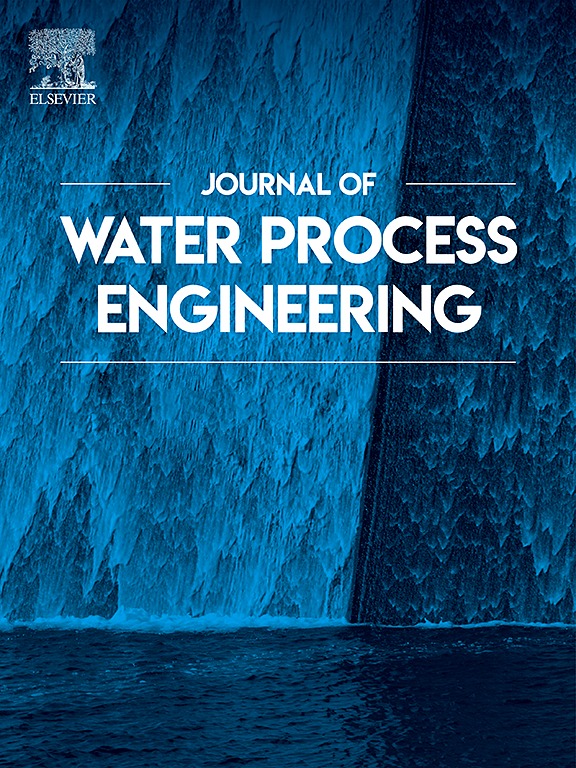利用生物电化学技术在厌氧基质中促进氯乙烯氧化生物降解的潜力
IF 6.7
2区 工程技术
Q1 ENGINEERING, CHEMICAL
引用次数: 0
摘要
氯乙烯(VC)是微生物对氯化溶剂(如过氯乙烯和三氯乙烯)进行氢解的有毒副产物。本研究在中试规模上使用微生物电化学通气管(MES)配置来评估生物电化学系统(BES),以增强厌氧基质中VC的氧化降解。3台BES运行9个月后,VC浓度从1840±2.1 μg/L降至检测不到的水平。建立了一个强大的氧化还原梯度,显著增加了目标处理区内的微生物电子转移。基于16S rrna的分类分析显示,电活性属如desulfurvibrio、sulphicurvum和f_Comamonadaceae的富集与系统电压和氯化物积累呈正相关,而没有检测到指示逐步脱氯过程的中间物。宏基因组学检测到与细胞外电子转移(如pilA, mtrC)和氧化降解途径(如alkB, pmoA)相关的基因丰度高,而vc -脱氯脱卤酶(如vcrA)缺失。MES通过使厌氧区的微生物间接获得氧气,可能促进氧依赖酶的活性。这些证据支持VC降解主要通过厌氧条件下的氧化途径进行,提供了BES可能刺激这种氧化生物降解的第一个证据,为VC污染位点的生物修复提供了另一种策略。本文章由计算机程序翻译,如有差异,请以英文原文为准。

Potential stimulation of oxidative biodegradation of vinyl chloride in an anaerobic matrix with a bioelectrochemical technology
Vinyl chloride (VC) is a toxic byproduct from microbial hydrogenolysis of chlorinated solvents such as perchloroethylene and trichloroethylene. This study evaluates a bioelectrochemical system (BES) using a microbial electrochemical snorkel (MES) configuration at pilot scale to enhance the oxidative degradation of VC in an anaerobic matrix. Three BES units were operated for nine months, reducing VC concentrations from 1840 ± 2.1 μg/L to non-detect levels. A robust redox gradient was established, significantly increasing the microbial electron transfer within target treatment zone. 16S rRNA-based taxonomic analysis revealed enrichment of electroactive genera such as Desulfurivibrio, Sulfuricurvum, and f_Comamonadaceae, correlating positively with system voltage and chloride accumulation, while no intermediate indicative of stepwise dechlorination process was detected. Metagenomics detected a high abundance of genes associated with extracellular electron transfer (e.g., pilA, mtrC) and oxidative degradation pathway (e.g., alkB, pmoA), while VC-dechlorinating dehalogenases (e.g., vcrA) were missing. The MES potentially facilitated oxygen-dependent enzyme activity by enabling indirect access for microorganisms in anaerobic zone to oxygen. These evidence supports that VC degradation proceeds primarily through an oxidative pathway under anaerobic conditions, providing the first evidence that BES may stimulate this oxidative biodegradation, offering an alternative strategy for bioremediation of VC-contaminated sites.
求助全文
通过发布文献求助,成功后即可免费获取论文全文。
去求助
来源期刊

Journal of water process engineering
Biochemistry, Genetics and Molecular Biology-Biotechnology
CiteScore
10.70
自引率
8.60%
发文量
846
审稿时长
24 days
期刊介绍:
The Journal of Water Process Engineering aims to publish refereed, high-quality research papers with significant novelty and impact in all areas of the engineering of water and wastewater processing . Papers on advanced and novel treatment processes and technologies are particularly welcome. The Journal considers papers in areas such as nanotechnology and biotechnology applications in water, novel oxidation and separation processes, membrane processes (except those for desalination) , catalytic processes for the removal of water contaminants, sustainable processes, water reuse and recycling, water use and wastewater minimization, integrated/hybrid technology, process modeling of water treatment and novel treatment processes. Submissions on the subject of adsorbents, including standard measurements of adsorption kinetics and equilibrium will only be considered if there is a genuine case for novelty and contribution, for example highly novel, sustainable adsorbents and their use: papers on activated carbon-type materials derived from natural matter, or surfactant-modified clays and related minerals, would not fulfil this criterion. The Journal particularly welcomes contributions involving environmentally, economically and socially sustainable technology for water treatment, including those which are energy-efficient, with minimal or no chemical consumption, and capable of water recycling and reuse that minimizes the direct disposal of wastewater to the aquatic environment. Papers that describe novel ideas for solving issues related to water quality and availability are also welcome, as are those that show the transfer of techniques from other disciplines. The Journal will consider papers dealing with processes for various water matrices including drinking water (except desalination), domestic, urban and industrial wastewaters, in addition to their residues. It is expected that the journal will be of particular relevance to chemical and process engineers working in the field. The Journal welcomes Full Text papers, Short Communications, State-of-the-Art Reviews and Letters to Editors and Case Studies
 求助内容:
求助内容: 应助结果提醒方式:
应助结果提醒方式:


